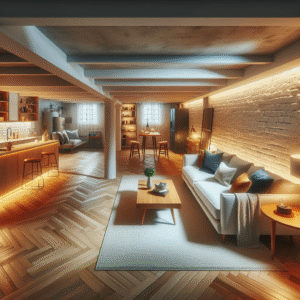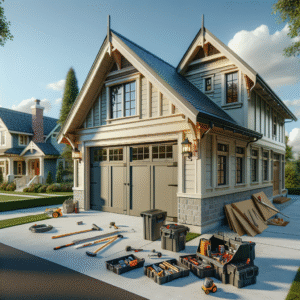Introduction to Decking Materials: Understanding Your Options
When it comes to building the perfect deck, the choice of materials is crucial. Not only does the right decking add aesthetic appeal to your home, but it also enhances its overall value. Whether you’re up against the harsh sun, relentless rains, or frosty winters, the material you choose must withstand your local climate. In this guide, we’ll dive deep into the most popular decking materials, helping you make an informed decision based on durability, maintenance needs, and cost-effectiveness.
Comprehensive Guide to Wood Decking: Types and Treatments
Types of Wood for Decking: Pros and Cons
Wood decking remains a popular choice due to its natural look and warmth. However, not all wood is created equal. From pressure-treated lumber to exotic hardwoods, each type offers unique characteristics. We’ll explore the benefits and drawbacks of different woods, helping you find the perfect match for your outdoor space.
Importance of Weather Resistance and Maintenance Tips
Maintaining the beauty of a wood deck requires understanding its susceptibility to weather. We’ll provide essential tips on protecting your wood deck from the elements, including recommended treatments and routine maintenance practices that can prolong its life and keep it looking great.
Exploring Alternative Deck Materials: Composite and Vinyl
Benefits of Composite Decking: Longevity and Low Maintenance
Composite decking is a fantastic alternative to traditional wood. Made from a blend of wood fibers and plastics, it’s designed to mimic the look of wood without the high maintenance. We’ll discuss why composite decking might be the right choice for you, focusing on its durability and minimal upkeep.
Why Choose Vinyl Decking? Cost-Effectiveness and Aesthetic Options
Vinyl decking is another excellent alternative that offers a variety of aesthetic options without breaking the bank. Known for its resistance to stains, weather, and moisture, vinyl is an ideal choice for many homeowners. Join us as we examine the cost benefits and diverse design choices available with vinyl decking.

If you’re ready to take your home improvement or construction project to the next level, we can help! Find trusted contractors on BuildNet, whether you’re looking for renovations, new builds, electrical work, plumbing, or anything in between. Our directory connects you with qualified professionals who can make your vision a reality.
Introduction to Decking Materials: Understanding Your Options
When it comes to building or renovating your outdoor living spaces, choosing the right decking material is a pivotal decision that not only shapes the aesthetic appeal of your deck but also its longevity and maintenance needs. Whether you’re nestled in a rainy region, basking in the sunbelt, or surviving the freeze-thaw cycles in colder climates, your choice of decking material can greatly influence the enjoyment and life span of your outdoor space.
Overview of Popular Deck Materials
Decking materials vary widely in terms of appearance, durability, cost, and required maintenance. Below is a quick rundown of some of the most popular choices that might catch your eye:
- Wood: Classic and natural, wood decking is favored for its warm aesthetic and versatility but requires regular maintenance to resist weather elements.
- Composite: Composed of wood fibers and recycled plastics, composite decking is robust against decay and easy to maintain.
- Vinyl: Also known as PVC decking, vinyl provides excellent moisture resistance and comes in a variety of colors.
- Aluminum: A less common choice, but noted for its durability, lightweight nature, and rot resistance.
Factors Influencing Material Choice: Climate, Durability, and Maintenance
Choosing the perfect decking material involves more than just picking a color or finish. Let’s delve into some critical factors that should guide your selection process:
Climate Impact
The climate you live in plays a crucial role in selecting the right decking material. For instance:
- Wet Climates: In areas with high moisture and heavy rainfall, materials like composite and vinyl are preferable as they resist rot and mold more effectively than traditional wood.
- Sunny and Hot Climates: If your deck will be constantly exposed to the sun, consider materials that resist UV damage and heat absorption, such as treated woods or UV-resistant composites.
- Cold Climates: For regions experiencing severe winters, choose decking materials that can withstand freeze-thaw cycles, such as pressure-treated or composite woods.
Durability and Lifespan
Durability is paramount if you want your deck to last. Hardwoods and composites generally offer longer lifespans compared to softwoods. For instance, hardwoods like ipe can last up to 40 years with proper maintenance, whereas cedar, a softwood, typically lasts about 15-20 years.
Maintenance Requirements
Think about how much time and effort you are willing to invest in maintaining your deck:
- Wood: Requires annual cleaning and staining or sealing to combat weathering and color fading.
- Composite: Needs only occasional washing with soap and water, making it a low-maintenance option.
- Vinyl: Very low maintenance, needing only periodic cleaning with mild soap to keep it looking new.
In conclusion, your choice in decking material should be a balance between your local climate, desired durability and lifespan, and how much maintenance you’re willing to perform. By considering these factors, you’re well on your way to selecting a material that not only looks great but also fits your lifestyle and local environment. Remember, a well-chosen deck not only enhances the beauty of your home but also adds to its value.

Comprehensive Guide to Wood Decking: Types and Treatments
Hey there! If you’re planning to spruce up your outdoor space with a new deck and have settled on wood as your material of choice, you’re in for a treat. Wood decking not only gives a warm, classic look to your backyard or patio, it also offers versatility and a range of options depending on your needs and preferences. Let’s dive into the different types of wood you can choose from and explore how to keep your deck looking great year after year.
Types of Wood for Decking: Pros and Cons
Choosing the right type of wood for your deck is crucial, and it largely depends on your climate, budget, and the look you want to achieve. Here are some of the most popular options:
- Cedar: Known for its rich color and natural beauty, cedar is highly resistant to moisture, decay, and insect damage. It’s also a softer wood, which means it’s more prone to scratches and dents.
- Redwood: Similar to cedar, redwood also boasts natural beauty and resistance to moisture and pests. It’s a bit more expensive but can last longer with proper care.
- Pressure-Treated Wood: This is a more budget-friendly option that’s treated with chemicals to resist rot, decay, and termites. While not as aesthetically pleasing as cedar or redwood, it can be stained or painted to enhance its appearance.
- Tropical Hardwoods: Woods like Ipe, Tigerwood, and Teak are incredibly durable and resistant to weather and insects. They’re also the most expensive options but can give your deck a unique, exotic look.
Each wood type has its own set of benefits and challenges, so consider what’s most important for your deck’s longevity and how much maintenance you’re willing to put in.
Importance of Weather Resistance and Maintenance Tips
No matter how durable your wood decking material claims to be, taking steps to protect it from the elements is key. Here’s why weather resistance is crucial and some maintenance tips to help you keep your deck in top condition:
- Sealing is Essential: Apply a high-quality sealer to your wood deck to protect it from moisture, which can lead to rot and warping. Reapply the sealer every two to three years, depending on your climate and the wood type.
- Cleaning Matters: Regular cleaning is not just about aesthetics; removing dirt and debris prevents mildew and mold growth, which can damage the wood over time. Use a soft brush and a mild detergent to clean your deck gently.
- Check for Damage: Inspect your deck at least once a year for any signs of damage such as loose nails, splintered wood, or rot. Early detection and repair can save you a lot of hassle and expense in the long run.
- Avoid Harsh Chemicals: While it might be tempting to use strong cleaners to tackle stubborn stains, they can strip away the wood’s natural oils and damage its finish. Stick to cleaners specifically formulated for wood decks.
Implementing these maintenance tips will not only extend the life of your deck but also enhance its natural beauty, making it a highlight of your home for years to come.
Whether you’re leaning towards the timeless charm of cedar, the durability of tropical hardwoods, or the affordability of pressure-treated wood, each type offers unique benefits. Remember, the key to a long-lasting wood deck is not just in choosing the right material but also in how well you maintain it. Happy decking!
Exploring Alternative Deck Materials: Composite and Vinyl
Hey there! Are you considering adding a deck to your cozy nest but dreading the thought of high maintenance and costly materials? Well, you’re in for a treat because today we’re diving deep into the world of alternative decking materials – primarily composite and vinyl. These options have been gaining traction and for good reasons. Let’s unpack these materials and see why they might just be the perfect fit for your home improvement project!
Benefits of Composite Decking: Longevity and Low Maintenance
If you’re looking for a decking material that blends beauty with practicality, composite decking might just be your best bet. Made from a blend of wood fibers and plastics, composite decks offer a stunning natural look without the high maintenance of traditional wood.
- Longevity: One of the standout features of composite decking is its durability. Unlike wood, composite materials are resistant to weather, insects, and rot, which means they can last anywhere from 25 to 30 years with proper care. That’s a significant upgrade in terms of lifespan!
- Low Maintenance: Say goodbye to the yearly ritual of sanding, staining, and sealing. Composite decks require little more than a regular cleaning with soap and water. This makes them an ideal choice for busy homeowners who don’t want to spend their weekends on deck upkeep.
Moreover, composite decking comes in a variety of colors and finishes, which allows for a customizable look that can suit any home style. From rich browns to cool greys, the array of choices means you can easily match your deck with the exterior of your home, creating a seamless and attractive outdoor living space.
Why Choose Vinyl Decking? Cost-Effectiveness and Aesthetic Options
Moving on to another fantastic decking material – vinyl. Known for its cost-effectiveness and versatile aesthetics, vinyl decking is a great option for homeowners who are looking for an affordable yet stylish decking solution.
- Cost-Effectiveness: Generally, vinyl decking is less expensive than composite decking both in terms of initial investment and long-term maintenance costs. It’s an economical choice that doesn’t compromise on quality.
- Aesthetic Options: Just like composite, vinyl decking is available in a range of colors and textures that mimic the look of real wood. Whether you’re after a rustic vibe or a contemporary look, vinyl can cater to your stylistic needs without the natural wood drawbacks.
Additionally, vinyl is highly resistant to moisture, making it an excellent choice for pool areas or regions with high humidity. Its non-porous surface means that mold, mildew, and stains are a thing of the past. Plus, the smooth surface of vinyl decking is comfortable underfoot, adding an extra layer of enjoyment to your outdoor living area.
Comparing Composite and Vinyl Decking
Choosing between composite and vinyl decking can be tough, as both offer compelling advantages. Here’s a quick rundown to help you decide:
- Durability: Both materials are highly durable, but composite tends to have a slight edge due to its blend of wood and plastic, which enhances strength.
- Maintenance: Both options are low maintenance, though vinyl can be slightly easier to clean due to its non-porous surface.
- Aesthetics: Composite decking usually offers a more natural wood-like appearance, while vinyl is available in a wide range of colors and patterns.
- Cost: Vinyl is typically more cost-effective both in initial costs and maintenance over time.
Whether you’re located in the bustling heart of a city or in a tranquil suburb, finding local contractors who specialize in these materials can be a breeze. For instance, searching for “composite decking installation near me” or “affordable vinyl decking options in [Your City]” can lead you to reputable service providers in your area who can bring your decking project to life, ensuring your outdoor space is both beautiful and functional.
By choosing either composite or vinyl decking, you’re opting for ease and efficiency without sacrificing style. So go ahead, dream big about your next outdoor project—these materials are designed to make your deck the highlight of your home!

FAQs on Decking Materials and Options
What are the most popular materials used for building decks?
The most popular decking materials include wood, composite, and vinyl. Each material offers different benefits, such as natural beauty for wood, durability for composite, and low maintenance for vinyl. The choice often depends on personal preference, climate, and budget.
How do I choose the best decking material for my home?
Consider several factors when choosing a decking material: local climate, maintenance requirements, durability, and aesthetics. For example, wood might be perfect for a traditional look but requires more maintenance. Alternatively, composite materials offer longevity and minimal upkeep but at a higher initial cost.
What are the pros and cons of wood decking?
Wood decking is favored for its classic, natural look. However, it requires regular maintenance like staining and sealing to prevent decay and damage. On the upside, wood is typically more cost-effective upfront compared to other materials.
Is composite decking worth the investment?
Composite decking is highly durable and resistant to rot, warping, and splintering, which often justifies its higher price point. It’s a great investment if you’re looking for a low-maintenance option with a long lifespan.
How does vinyl decking compare to wood and composite?
Vinyl decking is known for its low maintenance and variety of color and pattern options. It generally costs less than composite but might not have the same natural look as wood. Vinyl is also weather-resistant and easy to clean, making it a practical choice for many homeowners.
What maintenance is required for wood decks?
Wood decks need to be cleaned regularly and treated with stain or sealant approximately every two to three years. This treatment helps to prevent moisture damage, rot, and wear from UV exposure.
Can I install a deck myself, or should I hire a professional?
While some homeowners may choose to undertake deck installation as a DIY project, hiring a professional is advisable for ensuring the deck is safely and properly constructed. Professionals can also help in choosing the right materials and treatments based on your local climate and usage needs.
How long do different types of decks last?
The lifespan of a deck varies based on the material and maintenance. Wood decks can last around 15 to 20 years with proper care, while composite and vinyl decks can last 25 to 30 years or more, thanks to their enhanced durability and resistance to natural elements.
Are there environmentally friendly decking options?
Yes, many decking materials are made from recycled materials. For instance, composite decks often combine recycled plastic and wood fibers. Selecting sustainably sourced wood is another way to reduce environmental impact.
What should I do if my deck gets damaged?
If your deck is damaged, assess the extent first. Minor issues might be repairable with DIY methods, but significant damage or structural concerns should be addressed by a professional. Regular inspections can help catch problems early before they require extensive repairs.
Conclusion
Choosing the right decking material is crucial to ensure that your deck suits your aesthetic, functional, and maintenance preferences. Whether you opt for the natural elegance of wood, the durability of composite, or the ease of vinyl, understanding the benefits and drawbacks of each can help you make an informed decision. Remember, maintenance is key to prolonging the life of your deck, no matter the material you choose.
If you’re considering adding a deck to your home or need to replace an existing one, don’t hesitate to reach out to the professionals. Visit BuildNet’s website to connect with experienced local contractors who can help bring your vision to life and provide a free quote. A well-designed and well-built deck not only enhances the beauty and functionality of your outdoor space but can also increase the value of your property. Make sure your deck project is in good hands with a reliable contractor from BuildNet!







